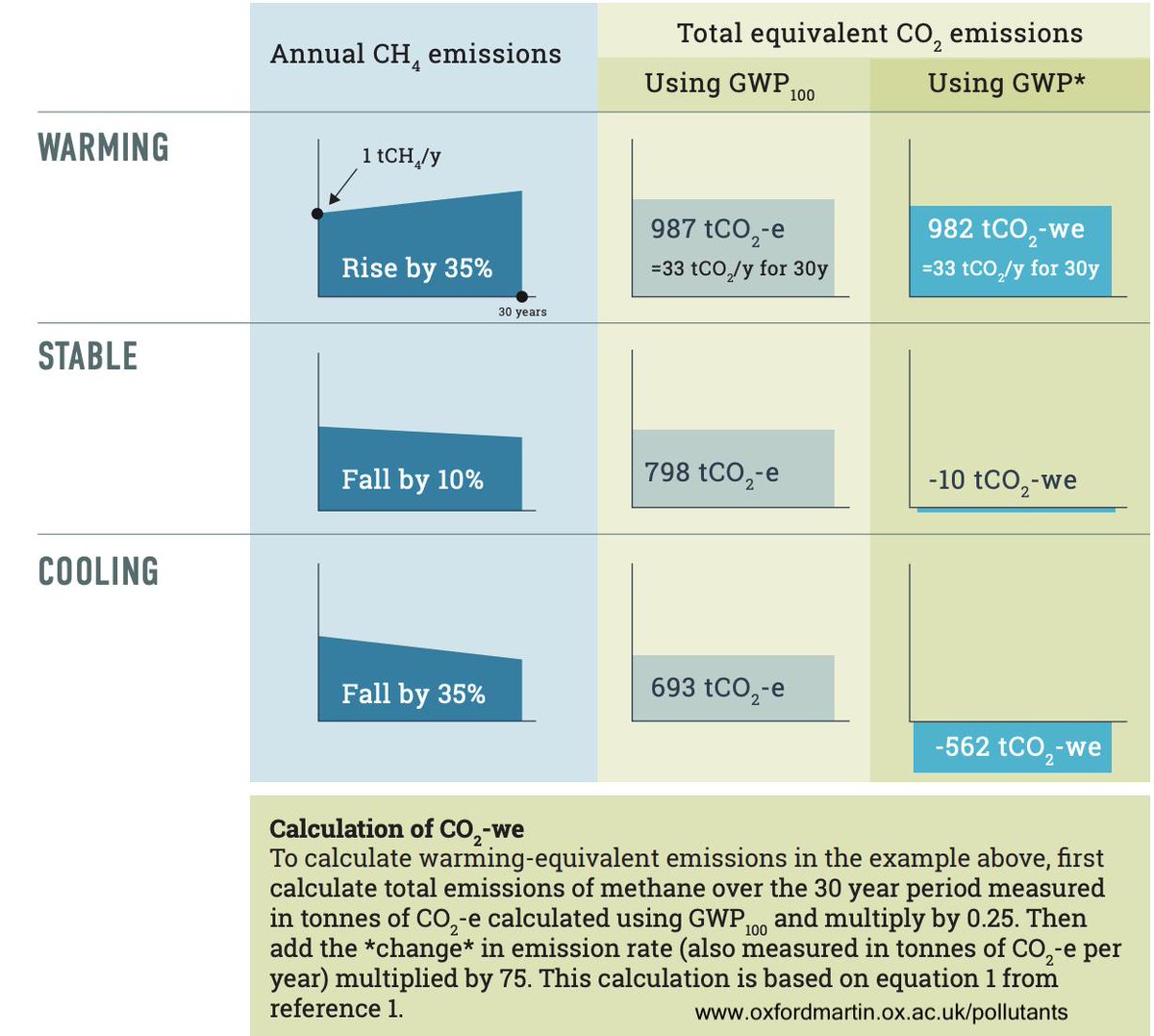I think the time has come to attempt a thread to explain our GWP* paper. I sense it& #39;s going to be long, as the topic is more suited to a 45-min seminar (30 at a push)... If you are keen on #methane and what the Paris Agreement means, this is for you. Otherwise, scroll on! 0/n
#Thread on our new paper about how you can think about tradeoffs between #methane (or other greenhouse gases) and CO2 for the Paris Agreement. The paper is here (free): https://go.nature.com/2xJFY7d ">https://go.nature.com/2xJFY7d&q... 1/n
CO2 accumulates in the atmosphere, so that is the most important gas to stop emitting to limit warming. We have to take it out of the air if we want to reduce the amount in the atmosphere without waiting 1000s of years. 2/n
So, it’s important that if you trade off CO2 with other gases (eg methane), you give them the “right” value. The same if you just want to compare how important they are relatively. 3/n
The most common way to compare is to multiply methane by its GWP100 (Global Warming Potential) to give a CO2-equivalent emission. Using this, emitting 1kg methane = 28 kg CO2e. 4/n
But, if you want to know how important different emissions are for warming in 2100, this metric is no good. Methane does not give 28x more warming in 2100 than CO2, as methane has a half-life of ~10 years so it’s mostly gone by then! 5/n
Note that there is still some impact from methane on temperature after 100 years including knock-on effects from the original emission, but a lot less. [Collins et al look at full effects here: http://stacks.iop.org/1748-9326/13/i=5/a=054003?key=crossref.70d07fb114d80fc70bd1b8927f03ac6b">https://stacks.iop.org/1748-9326... ] 5b/n
In the paper, we show a modified use of GWP called GWP*, where we take into account this short lifetime. Using GWP*, the CO2e* emissions all give similar (not identical) temperature responses. 6/n
[For the definition of GWP*, and all kinds of other good stuff, see the new paper: https://www.nature.com/articles/s41612-018-0026-8">https://www.nature.com/articles/... which builds on previous work: https://www.nature.com/articles/nclimate2998">https://www.nature.com/articles/... (which has some nice graphs in fig2) 6b/n ]
CO2e* emissions each contribute equivalently to warming, unlike the usual CO2e emissions. They can be used in a (dare I say it) carbon budget framework to try and limit warming to the Paris goals. 7/n
This is equivalence is key. When people currently report CO2e emissions without telling you what metric is used or what proportion is from which gas, you can’t know (a) the component emissions or (b) what warming we might expect 8/n
GWP* provides equality for all greenhouse gas emissions so they can be fairly judged for their warming. This becomes more important with more ambitious emissions cuts. See this tiny briefing doc for more: https://www.oxfordmartin.ox.ac.uk/publications/view/2601">https://www.oxfordmartin.ox.ac.uk/publicati... 9/n
When I say equality, I mean relative to GWP100. GWP* is not perfect, but then nothing is, and climate emission metrics definitely aren’t! 9b/n
Tl;dr: GWP* provides relative equality for all greenhouse gas emissions so they can be fairly judged for their warming impacts. Which is (I believe) what the Paris Agreement wants. The new paper: https://go.nature.com/2xJFY7d ">https://go.nature.com/2xJFY7d&q... 10/n
Next are some links for other takes on the paper. If you liked this #thread, I explain things in a similar but more waffley way in this 3min45 video: https://www.youtube.com/watch?v=HATNvcluCKE">https://www.youtube.com/watch... 11/n
Coauthor Dave Frame from @VicUniWgtn is interviewed on in this @nzherald article about the paper: https://www.nzherald.co.nz/nz/news/article.cfm?c_id=1&objectid=12064270">https://www.nzherald.co.nz/nz/news/a... 12/n
News story with links to related info: https://www.oxfordmartin.ox.ac.uk/news/2018_news_Climate_Pollutants_GWP">https://www.oxfordmartin.ox.ac.uk/news/2018... acknowledgements: @janfug @oxmartinschool @ecioxford @UniRdg_Met @VicUniWgtn +more! 13/n
AND FINALLY, to find out why this all means that cows are like closed power stations, see my @CarbonBrief guest post: https://www.carbonbrief.org/guest-post-a-new-way-to-assess-global-warming-potential-of-short-lived-pollutants">https://www.carbonbrief.org/guest-pos... (which also explains the paper more thoroughly than here!) n/n
PS We have published a follow up paper that makes the case for CO2-warming-equivalence. Until I make a thread on that, I& #39;ll just add the link to the paper here for your perusal: https://www.nature.com/articles/s41612-019-0086-4">https://www.nature.com/articles/... n+1/n
PPS Note that the equation in the 2018 paper is modified to get the new usage in the 2019 paper. we basically added some weighting to GWP* to improve the fit with warming outcome. n+2/n
We now have an agriculture-focussed explainer of the new work, which includes an example calculation (see image): https://www.oxfordmartin.ox.ac.uk/publications/net-zero-for-agriculture/
n+3/n">https://www.oxfordmartin.ox.ac.uk/publicati...
n+3/n">https://www.oxfordmartin.ox.ac.uk/publicati...
Our most recent paper on GWP* has appeared! Lynch et al in @IOPenvironment, with idealised examples: Demonstrating GWP*: a means of reporting warming-equivalent emissions that captures the contrasting impacts of short- and long-lived climate pollutants https://doi.org/10.1088/1748-9326/ab6d7e">https://doi.org/10.1088/1...
Here& #39;s the story on the @oxmartinschool website: https://www.oxfordmartin.ox.ac.uk/news/get-the-maths-right-on-emissions-or-risk-missing-temperature-target-warn-oxford-scientists/">https://www.oxfordmartin.ox.ac.uk/news/get-...

 Read on Twitter
Read on Twitter


